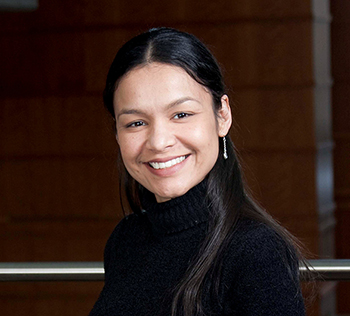
Yarimar Carrasquillo, Ph.D.
Investigator
Section on Behavioral Neurocircuitry and Cellular Plasticity
NCCIH
Research Topics
Behavioral responses to painful stimuli can be amplified or suppressed by many factors, including expectations, experiences, and context. My lab is interested in identifying brain mechanisms underlying bidirectional modulation of pain and in determining whether these processes are sex dependent.
We use cellular physiology, molecular genetics, neuroanatomy, and behavioral rodent assays to tackle questions at molecular, cellular, and circuit levels that we then causally link to pain-related behaviors. We have focused on the central amygdala (CeA), a forebrain limbic structure well positioned to link noxious stimuli to defense and affective responses. Our studies uncovered a dual function of the CeA in pain processing, showing that this brain region bidirectionally modulates pain and that the directionality of pain modulation is encoded by cell-type-specific changes in neuronal activity. At the cellular level, we have shown that genetically distinct CeA neurons are also morphologically and electrophysiologically distinct. At the circuit level, we identified and functionally characterized CeA efferent and afferent projections that modulate pain-related behaviors. Our studies have further shown important sex differences in brain mechanisms of pain modulation.
When studying pain, it is important to recognize that the experience of pain is complex and involves reciprocal interactions between physical pain and affective states. For example, painful stimuli are typically unpleasant and aversive while pain relief is typically rewarding and can induce positive affective states. In contrast, aversive stimuli like acute stress exposure or negative affective states like fear have been shown to result in robust analgesia. Our ongoing efforts are focused on studying brain mechanisms underlying the intersection of physical pain with affective states.
Biography
Dr. Yarimar Carrasquillo joined the Pain and Integrative Neuroscience Branch of the National Center for Complementary and Integrative Health (NCCIH) at the National Institutes of Health (NIH) as an Investigator in 2014. Her research program is focused on understanding the neural mechanisms underlying the physiological sensation of pain as well as the alterations that occur at the cellular and circuit levels that lead to pathological pain states.
Dr. Carrasquillo received her B.S. in Biology from the University of Puerto Rico, Rio Piedras and her Ph.D. in Neuroscience from Baylor College of Medicine, followed by postdoctoral training in cellular neurophysiology at Washington University School of Medicine. Her graduate work established a causal link between amygdala plasticity and changes in persistent pain-related behaviors and further demonstrated a hemispheric lateralization of function in amygdala-mediated modulation of pain in mice. Her postdoctoral studies contributed to the molecular and functional characterization of voltage-gated potassium and sodium currents in central neurons. Since joining NIH as a principal investigator, Dr. Carrasquillo's team has uncovered a previously underappreciated dual function of the amygdala in the modulation of pain, demonstrating that this brain structure functions as a pain rheostat that can amplify or decrease pain.
Dr. Carrasquillo is also strongly committed to and invested in fostering the career development of students and trainees of all backgrounds, particularly underrepresented minorities, trainees with underprivileged and disadvantageous backgrounds and women in science. She is also strongly committed to promoting scientific rigor, transparency and reproducibility in research and in training scientists that understand, value, and exercise scientific integrity throughout their work.
Selected Publications
- Wilson TD, Valdivia S, Khan A, Ahn HS, Adke AP, Martinez Gonzalez S, Sugimura YK, Carrasquillo Y. Dual and Opposing Functions of the Central Amygdala in the Modulation of Pain. Cell Rep. 2019;29(2):332-346.e5.
- Adke AP, Khan A, Ahn HS, Becker JJ, Wilson TD, Valdivia S, Sugimura YK, Martinez Gonzalez S, Carrasquillo Y. Cell-Type Specificity of Neuronal Excitability and Morphology in the Central Amygdala. eNeuro. 2021;8(1).
- Francis-Malavé AM, Martínez González S, Pichardo C, Wilson TD, Rivera-García LG, Brinster LR, Carrasquillo Y. Sex differences in pain-related behaviors and clinical progression of disease in mouse models of colonic pain. Pain. 2023;164(1):197-215.
- Singh S, Wilson TD, Valdivia S, Benowitz B, Chaudhry S, Ma J, Adke AP, Soler-Cedeño O, Velasquez D, Penzo MA, Carrasquillo Y. An inhibitory circuit from central amygdala to zona incerta drives pain-related behaviors in mice. Elife. 2022;11.
- Torres-Rodriguez JM, Wilson TD, Singh S, Torruella-Suárez ML, Chaudhry S, Adke AP, Becker JJ, Neugebauer B, Lin JL, Martinez Gonzalez S, Soler-Cedeño O, Carrasquillo Y. The parabrachial to central amygdala pathway is critical to injury-induced pain sensitization in mice. Neuropsychopharmacology. 2023.
Related Scientific Focus Areas


Molecular Biology and Biochemistry
View additional Principal Investigators in Molecular Biology and Biochemistry


Social and Behavioral Sciences
View additional Principal Investigators in Social and Behavioral Sciences

This page was last updated on Thursday, October 12, 2023